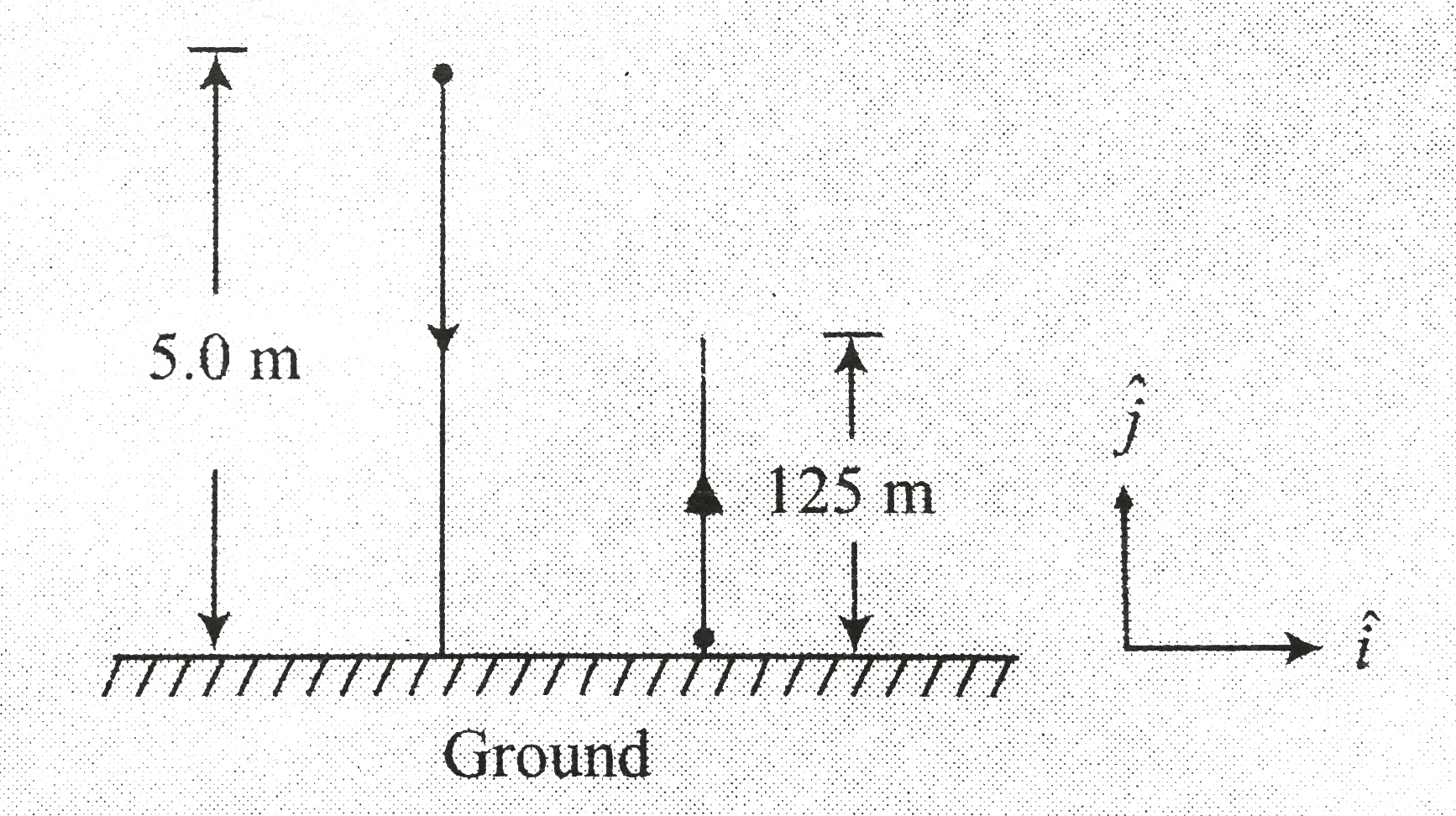A body of mass m falls from a height h1 and rises to a height h2. The magnitude of the change in momentum during the impact with the ground.
mg(h1+h2)
m(√2gh1+√2gh2)
m(√2gh1−√2gh2)
Zero
The correct Answer is:B
To find the magnitude of the change in momentum during the impact of a body of mass m that falls from a height h1 and rises to a height h2, we can follow these steps:
Step 1: Calculate the initial velocity just before impact
When the body falls from height h1, its potential energy is converted to kinetic energy just before it hits the ground. The potential energy at height h1 is given by:
PE=mgh1
This potential energy converts into kinetic energy (KE) just before impact:
KE=12mv2
Setting the potential energy equal to the kinetic energy:
mgh1=12mv2i
From this, we can solve for the initial velocity vi just before impact:
vi=√2gh1
Step 2: Calculate the final velocity just after rebound
After hitting the ground, the body rebounds to a height h2. At this height, the kinetic energy just after impact converts back to potential energy:
PE=mgh2
Setting the kinetic energy equal to the potential energy at height h2:
12mv2f=mgh2
From this, we can solve for the final velocity vf just after rebound:
vf=√2gh2
Step 3: Determine the change in momentum
The change in momentum Δp is given by the mass times the change in velocity:
Δp=m(vf−vi)
Substituting the expressions for vf and vi:
Δp=m(√2gh2−√2gh1)
Step 4: Calculate the magnitude of change in momentum
Since we are interested in the magnitude of the change in momentum, we take the absolute value:
|Δp|=m(√2gh2+√2gh1)
Final Result
Thus, the magnitude of the change in momentum during the impact with the ground is:
|Δp|=m(√2gh2+√2gh1)
When the body falls from height h1, its potential energy is converted to kinetic energy just before it hits the ground. The potential energy at height h1 is given by:
PE=mgh1
This potential energy converts into kinetic energy (KE) just before impact:
KE=12mv2
Setting the potential energy equal to the kinetic energy:
mgh1=12mv2i
From this, we can solve for the initial velocity vi just before impact:
vi=√2gh1
After hitting the ground, the body rebounds to a height h2. At this height, the kinetic energy just after impact converts back to potential energy:
PE=mgh2
Setting the kinetic energy equal to the potential energy at height h2:
12mv2f=mgh2
From this, we can solve for the final velocity vf just after rebound:
vf=√2gh2
The change in momentum Δp is given by the mass times the change in velocity:
Δp=m(vf−vi)
Substituting the expressions for vf and vi:
Δp=m(√2gh2−√2gh1)
Since we are interested in the magnitude of the change in momentum, we take the absolute value:
|Δp|=m(√2gh2+√2gh1)
Thus, the magnitude of the change in momentum during the impact with the ground is:
|Δp|=m(√2gh2+√2gh1)
Topper's Solved these Questions
- LAWS OF MOTIONBOOK - AAKASH SERIESCHAPTER - LAWS OF MOTIONEXERCISE - EXERCISE - II
136 Videos
- GEOMETRICAL OPTICSBOOK - AAKASH SERIESCHAPTER - GEOMETRICAL OPTICSEXERCISE - ADDITIONAL PRACTICE EXERCISE (LEVEL-II PRACTICE SHEET (ADVANCED) INTEGER TYPE QUESTIONS)
10 Videos
- LOGIC GATESBOOK - AAKASH SERIESCHAPTER - LOGIC GATESEXERCISE - Exercise (Very Short Answer)
10 Videos
Similar Questions
A ball of mass 1 kg is dropped from 20 m height on ground and it rebounds to height 5m. Find magnitude of change in momentum during its collision with the ground. (Take g=10m/s2)
View SolutionA body of mass m=2kg falls from a height h=10m from the ground level .
What is the magnitude of total change in momentum of the body before it strikes the ground?
View SolutionA body of mass m=1kg falls from a height h=20m from the ground level .
(a) What is the magnitude of total change in momentum of the body before it strikes the ground?
(b) What is the corresponding average force experienced by it ?(g=10ms−1)
View SolutionA rubber ball of mass 50 g falls from a height of 5m and rebounds to a height of 1.25 m. Find the impulse and the average force between the ball and the ground if the time for which they are in contact was 0.1s

View SolutionA body of mass 0.2 kg falls from a height of 10 m to a height of 6 m above the ground. Find the loss in potential energy taking place in the body.
[g=10ms−2]
View SolutionA rubber ball falls from a height h and rebounds to a height h/2. A rubber ball of double the mass falling from the same height h rebounds to a height
View SolutionTwo bodies of masses m1andm2 fall from heights h1andh2 respectively. The ratio of their velocities when the hit the ground is
View SolutionA cage of mass M hangs from a light spring of force constant k. A body of mass m falls from height h inside the cage and stricks to its floor. The amplitude of oscillations of the cage will be-
_E01_061_Q01.png)
View SolutionA steel ball of mass 0.1 kg falls freely from a height of 10 m and bounces to a height of 5.4 m from the ground. If the dissipated energy in this process is absorbed by the ball, the rise in its temperature is (specific heat of steel =460K/kg∘/C,g=10m/s2)
View SolutionA plastic ball falls from a height of 4.9 metre and rebounds several times from the floor. What is the coefficient of restitution during the impact with the floor if 1.3 seconds pass from the first impact to the second one ?
View Solution
